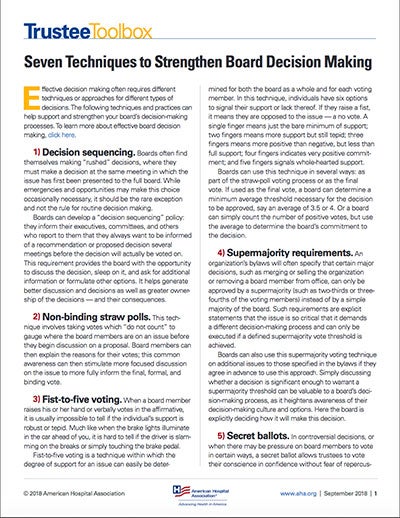Board Meetings
New Approaches to Effective Board Decision Making
Seven techniques to help support and strengthen your board’s deliberation processes
By Jamie Orlikoff
Practical
Governance
You are on a busy but fast-moving highway heading out of town for the Fourth of July holiday when the brake lights of the car in front of you illuminate. Can you tell just from the brake lights whether the driver in front of you is slowing down or is stomping the brake in a panic stop? No. All the brake lights tell you is that the driver has engaged the brake to some degree. You must look quickly for other clues to estimate that degree and immediately decide what to do. The brake light only gives you one piece of limited, binary information: it is either on or off. You must make a quick decision based on this information and certain clues and assumptions. The wrong decision can have disastrous consequences.
Different drivers approach this scenario in different ways. Some always make the same assumptions (the driver in front is just slowing down a bit), while others adjust their assumptions and reading of clues to the conditions and changing risk profiles. The drivers who adjust, who use a variety of clues — and who use different processes to make these frequent, seemingly identical but actually very different and critical decisions — are the ones most likely to avoid accidents. They use different processes to arrive at different decisions in common situations with different variables, and they make better decisions by doing so.
Many boards are similar to the driver who always makes the same assumptions about the brake lights out in front: they use the same process and techniques to make decisions in similar situations with importantly different circumstances and risk profiles.
Obstacles to Effective Decision Making
The first thing that any effective decision-making body, like a board, does is explicitly decide how it will make decisions. Further, effective boards develop different, clearly defined processes to make decisions of different magnitudes. Yet, many boards have never had an explicit conversation about or developed multiple approaches to this most critical of governance functions — their decision making. As a result, the vast majority of boards have a very limited tool kit of processes and techniques for making effective decisions.
There are two very common foundational problems with board decision making: a culture of unanimity and having only one decision-making process. In a culture of unanimity, there is a strong expectation that every board member will vote in support of the motion before the board or against it if that is the board’s signal. A review of the meeting minutes of a variety of boards will demonstrate this: the overwhelming majority of board votes are unanimous. Many board members cannot remember ever having a non-unanimous vote.
In some boards the expectation of unanimity is so strong that even in the rare instance of one or two dissenting votes cast, the board chair says something akin to “the majority has clearly spoken, so let’s make it unanimous.” Why? What is wrong with dissenting votes? Why must every board member agree?
In his book The Effective Executive, Peter Drucker provided a clear answer to the weakness of consensus and unanimity: “To make more effective decisions, develop disagreement rather than consensus. Disagreement provides alternatives and makes you think more deeply about the issue. In fact, if you don’t have disagreement, you’re not ready to make a decision.”
The second foundational problem with board decision making both flows from and supports the culture of unanimity: having one dominant, if not exclusive, approach to making decisions. This common decision-making process involves two characteristics: (1) binary decisions and (2) simple majority rule. Like the brake lights on a car, the vast majority of decisions boards make are binary: they vote yes or no, approving or rejecting the motion before them. As a result, and consistent with a culture of unanimity, it is impossible for most boards to be able to discern the honest degree of commitment to the issue being voted on by the board members from the vote alone, just like it is impossible to discern how aggressively a driver is hitting the brakes from the brake lights alone.
Many CEOs and boards misinterpret a unanimous vote for shared, deep commitment to the issue by all board members when in fact it often reflects tepid support at best due to the culture of unanimity, a rushed decision, or some other governance decision dysfunction. This miscalculation can cause boards to second guess, undercut or prematurely reverse formal decisions that they previously have made, with many possible negative consequences, including precipitating the termination of the CEO. This “unanimously approve now, challenge and dissent later” dynamic is an unfortunate but common form of governance dysfunction and one directly related to the limited and limiting binary decision-making process.
Many boards default to the binary decision process for all of their decisions, with many using the same process to approve the minutes of their last meeting as they do to approve a major merger or strategic initiative. The binary decision process indeed has its place in effective board decision making, but it should be one of a number of processes, tools and techniques for effective board decision making.
Effective boards avoid binary decision making as their only decision-making process. They identify those issues that are so critical and consequential that they expect and insist on being engaged in the early phases of the decision-making process, in the multiplication of alternatives, and in the challenging of assumptions. This process involves the board’s actually framing and refining the ultimate binary question (do we do this or not?) and deeply understanding the implications and risks, rather than just being presented with a pre-baked decision. When a board makes a bad decision, one of the biggest reasons it does so is it makes its choices more limited than they have to be.
Techniques for Better Decision Making
Many trustees are surprised to discover that there are many approaches and techniques for more effective board decision making. Some of these include:
- Decision sequencing. Boards often find themselves making “rushed” decisions, where they must make a decision at the same meeting in which the issue has first been presented to the full board. While emergencies and opportunities may make this choice occasionally necessary, it should be the rare exception and not the rule for routine decision making.
Boards can develop a “decision sequencing” policy: they inform their executives, committees, and others who report to them that they always want to be informed of a recommendation or proposed decision several meetings before the decision will actually be voted on. This requirement provides the board with the opportunity to discuss the decision, sleep on it, and ask for additional information or formulate other options. It helps generate better discussion and decisions as well as greater ownership of the decisions — and their consequences.
- Non-binding straw polls. This technique involves taking votes which “do not count” to gauge where the board members are on an issue before they begin discussion on a proposal. Board members can then explain the reasons for their votes; this common awareness can then stimulate more focused discussion on the issue to more fully inform the final, formal, and binding vote.
- Fist-to-five voting. When a board member raises his or her hand or verbally votes in the affirmative, it is usually impossible to tell if the individual’s support is robust or tepid. Much like when the brake lights illuminate in the car ahead of you, it is hard to tell if the driver is slamming on the breaks or simply touching the brake pedal.
Fist-to-five voting is a technique within which the degree of support for an issue can easily be determined for both the board as a whole and for each voting member. In this technique, individuals have six options to signal their support or lack thereof. If they raise a fist, it means they are opposed to the issue — a no vote. A single finger means just the bare minimum of support; two fingers means more support but still tepid; three fingers means more positive than negative, but less than full support; four fingers indicates very positive commitment; and five fingers signals whole-hearted support.
Boards can use this technique in several ways: as part of the straw-poll voting process or as the final vote. If used as the final vote, a board can determine a minimum average threshold necessary for the decision to be approved, say an average of 3.5 or 4. Or a board can simply count the number of positive votes, but use the average to determine the board’s commitment to the decision.
- Supermajority requirements. An organization’s bylaws will often specify that certain major decisions, such as merging or selling the organization or removing a board member from office, can only be approved by a supermajority (such as two-thirds or three-fourths of the voting members) instead of by a simple majority of the board. Such requirements are explicit statements that the issue is so critical that it demands a different decision-making process and can only be executed if a defined supermajority vote threshold is achieved.
Boards can also use this supermajority voting technique on additional issues to those specified in the bylaws if they agree in advance to use this approach. Simply discussing whether a decision is significant enough to warrant a supermajority threshold can be valuable to a board’s decision-making process, as it heightens awareness of their decision-making culture and options. Here the board is explicitly deciding how it will make this decision. - Secret ballots. In controversial decisions, or when there may be pressure on board members to vote in certain ways, a secret ballot allows trustees to vote their conscience in confidence without fear of repercussion or reprisal. This technique is very useful for a board that has a culture of unanimity in decision making and wishes to change it. Secret-ballot voting can also be an especially important decision-making tool for boards required to have meetings open to the public. If allowed by law, a secret ballot enables the board members to be more likely to vote their conscience and make difficult but necessary decisions even when members of the public and press are in the room, most of whom are vocally opposed to the action being considered by the board.
- Avoiding decision fatigue by restructuring board agendas. The more decisions a board makes, the more it suffers from decision fatigue and the resulting deterioration in the quality of decision making. Yet, most boards put the most meaningless, pro-forma decision issues (approval of minutes, consent agenda, approval of reports, etc.) at the beginning of the agenda, and place the most significant decision at the conclusion of the agenda. A simple technique to improve board decision making is to flip the script and place the significant decisions at the beginning of the meeting, and put the more routine ones, which are far less likely to be negatively affected by decision fatigue, at the end of the agenda.
- Authority matrix. Boards can use an authority matrix to create a decision protocol that clearly defines what type of decisions will be made by the board as distinct from executive management; from board committees, if they have delegated decision-making authority; from the medical staff; or from other boards or decision-making groups in the system or organization. By clearly defining the role of each body in the making of a specific decision (who recommends, who approves, and who must be consulted before a decision is made?), mystery in the decision-making process is replaced by mastery.


